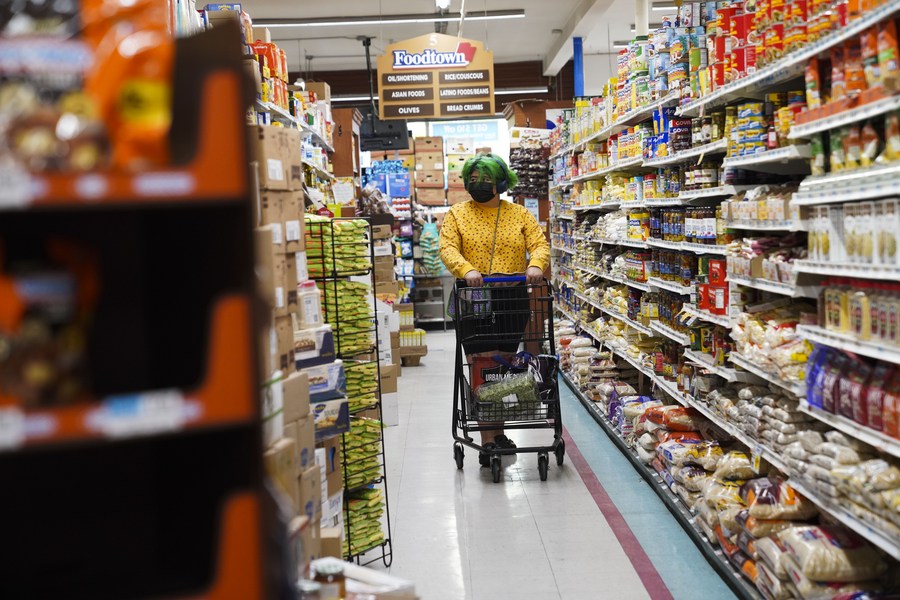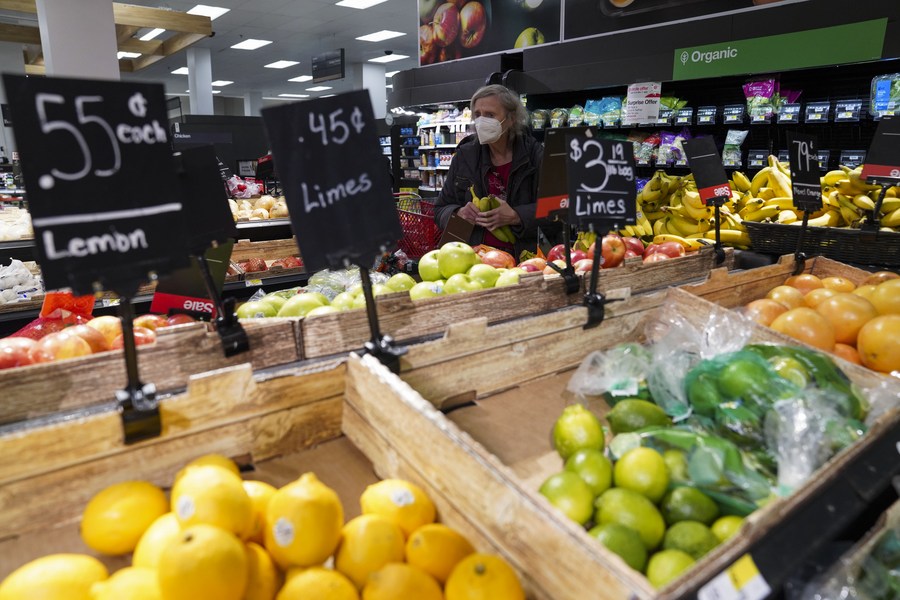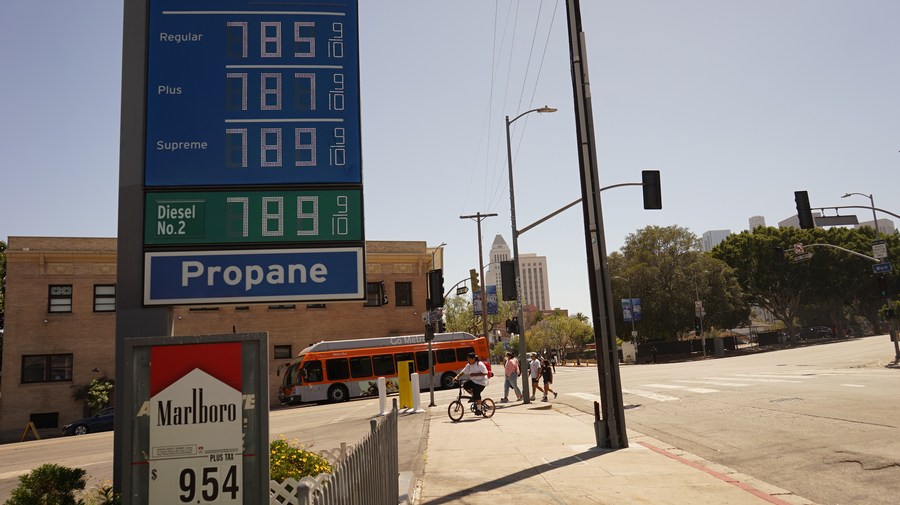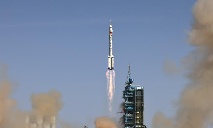U.S. CPI ticks up to 8.6 pct in May as Fed struggles to tame inflation

A customer shops at a store in New York, the United States, May 11, 2022. (Xinhua/Wang Ying)
Economists noted that another 50-basis-point rate hike is "all but assured" at next week's FOMC meeting, and a couple more 50-basis-point hikes in July and September seem "highly likely."
WASHINGTON, June 10 (Xinhua) -- U.S. consumer inflation in May surged 8.6 percent from a year ago, indicating inflation remains elevated despite the Federal Reserve's rate hikes, the U.S. Labor Department reported Friday.
The consumer price index (CPI) last month rose 1.0 percent from the previous month after increasing 0.3 percent in April, according to the department's Bureau of Labor Statistics (BLS).
The May CPI surged 8.6 percent from a year earlier, a larger increase compared with the 8.3-percent growth in April, marking the third straight month of inflation over 8 percent. The March figure was 8.5 percent.
The May CPI was the largest 12-month increase since the period ending December 1981. Headline CPI has remained over 6 percent year on year since October last year.
Although price growth has started to show signs of easing, the latest data is a stark reminder that the Fed has a long way ahead as it aims to bring elevated inflation under control.
The central bank raised its target federal funds rate by a quarter percentage point from near zero in March, beginning its tightening cycle to curb the surging inflation. In May, the Fed increased the rate by half a percentage point and has signaled more half-point hikes going forward, stoking recession fears.
"Simply put, inflation remains far too high for the Federal Reserve's liking," Sarah House and Michael Pugliese, economists at the Wells Fargo Securities, wrote in an analysis.

A customer shops for fruit at a Target store in New York, the United States, Jan. 12, 2022. (Xinhua/Wang Ying)
"Until inflation is demonstrably on the downswing, we expect the FOMC (Federal Open Market Committee) to fight back aggressively with tighter policy," House and Pugliese said, referring to the Fed's policy-setting body.
The so-called core CPI, which excludes food and energy, rose 0.6 percent in May following a 0.6-percent growth the prior month. Core CPI jumped 6.0 percent over the last 12 months, after climbing 6.2 percent in April.
The increase in prices was broad-based, with the indexes for shelter (which includes rents and homeownership costs), gasoline, and food being the largest contributors, according to the BLS report.
"Core goods inflation had shown some signs of slowing over the past few months, but this trend largely reversed course in May," House and Pugliese said.
The food CPI index rose 1.2 percent in May as the food at home index increased 1.4 percent. The food index increased 10.1 percent for the 12 months ending May, the first increase over 10 percent since the period ending March 1981.
After declining in April, the energy index rose 3.9 percent over the month with the gasoline index rising 4.1 percent. The energy index rose 34.6 percent over the last year, the largest 12-month increase since the period ending September 2005.
The U.S. national average price for a gallon of regular gasoline hit a fresh record high of 4.986 U.S. dollars on Friday, up roughly 14 percent from a month ago, according to the American Automobile Association (AAA).
"This dynamic between decreased supply and increased demand is contributing to rising prices at the pump," the AAA said in a statement. "This coupled with increasing crude oil prices means that the price of gas will likely remain elevated for the near future."

Gas prices are displayed at a gas station in Los Angeles, California, the United States, June 1, 2022. (Photo by Zeng Hui/Xinhua)
House and Pugliese noted that another 50-basis-point rate hike is "all but assured" at next week's FOMC meeting, and a couple more 50-basis-point hikes in July and September seem "highly likely."
As the Fed takes more aggressive steps to rein in the highest inflation in four decades, many economists believe that with a mix of high inflation and low unemployment, it would be very difficult for the Fed to tame soaring inflation without a recession.
"The Federal Reserve is committed to reducing demand to meet a supply-constrained world. This inflation reading will strengthen that resolve," said Yelena Maleyev, economist at the major accounting firm Grant Thornton.
"The more consumers spend, the more the Fed has to tighten policy; this ups the risk of a recession," she said.
Maleyev noted that her team expects the unemployment rate to rise above 5 percent before inflation is tamed. U.S. unemployment rate unchanged at 3.6 percent in May amid continued labor market tightness, just slightly above the 50-year low of 3.5 percent before the pandemic.
Initial jobless claims in the United States last week rose by 27,000 to reach 229,000, hitting the highest level in five months, U.S. Labor Department reported on Thursday. Some economists took this as a sign that the labor market is starting to cool.
The number of job openings decreased by 455,000 to 11.4 million by the end of April, still historically high. The number of unemployed persons was 6.0 million in May, meaning that there were 1.9 job positions for every unemployed and companies were still struggling to hire.
Photos
Related Stories
- Interview: With several countries absent, U.S. Summit of the Americas "a failure before it started"
- U.S. lawmaker characterizes rate of school shootings as "mark of global shame": report
- Upcoming widespread blackouts "national disgrace" for U.S.: report
- Syrian president accuses U.S. of using dollar to commit global "robbery"
- Same-old trick
Copyright © 2022 People's Daily Online. All Rights Reserved.









